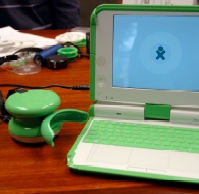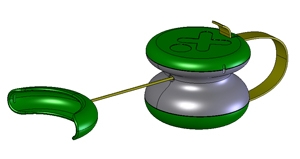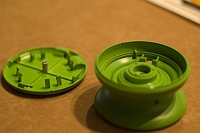Reading the specifications sheet, it looks as if Potenco is still testing the OLPC yo-yo power generator.
There is no information on the resistance force (which seems to be variable, or the stroke length - I'll assume it's two meters so an adult won't run out of cord while using both hands), but it's interesting to see a spec saying that fatigue sets in at ten minutes.
Is there a way to adjust the resistance so that one could go for a longer time? Probably not, since I assume that the resistance is cleverly calculated to maximize the power output. It's also very interesting to see the idea floated of hooking two of these to your belt and using foot power.
Maybe if you lay on your back and did leg thrusts in the air it might work out. But walking with these - well, mostly in walking the legs don't extend and retract, but swing back and forth to organize a "falling forward" mode of locomotion.
Perhaps the yo-yo should be fastened to one ankle and the string to another. But then the walking-through-molasses feel might not be conducive to a lot of moving about.
And then there's the spring, which puts a 50 percent limit on the energy transfer.
You pull on the string and some of the energy is converted into electrical power, while the rest goes to extending the spring. A halfway intelligent design will then use the spring return to generate electricity. Of course, no power then comes from you, so you operate at a 50 percent duty cycle.
But wait - it gets worse. The 50 percent figure would be correct if you let the string snap back (which eats a little spring power in itself), but usually such a snapping action would present wear problems as well as break up the continuity of operation by requiring you to release and grab the handle again. Keeping your hand on the handle takes a little energy from the spring and some from you to re-extend your arm against the spring.
Perhaps the more important effect would be on your comfort - the time for operation is extended by a factor of two as compared with a double-action device, plus the unidirectional loading doesn't help (here we need more input from people familiar with the physical and psychological kinesiology of exercise machines).
I suggest that more energy can be extracted from a human by means of a steady, symmetrical load than through a unidirectional load having little resistance on the backstroke. You are not only using only one set of muscles on one side of the body under unidirectional and unilateral rules, but are bringing he body into a tired condition without getting the energy that might be available from shorter bursts of more sustained exertion.
The body is not a linear system. It is not conducive to facile models, as there are many dimensions to consider. State of mind is also a real consideration - one of the reasons exercise equipment have profiles available for user selection which include visual indicators of imaginary hills one is climbing or descending at any given instant is to reduce dissatisfaction when an unforeseen load appears.
The mind works through metaphors and will create them if not presented with a familiar one. "Hitting the wall" is a vivid metaphor for a very real state of mind. Athletes train to be able to get through this condition, but are we to expect every user to be a trained athlete? Hardly.
I would love to hear more about how this device is designed with the user and the expected metaphors of use in mind. I'd love to know what the design factors were that dictated this configuration.
How was the electrical loading determined, given the complexity of human behavior with regard to exercise and fatigue? Were the characteristics of the battery charger taken into account?
The best design would have the charger and generator designed at the same time, taking into account the models and measurements that would flow from a thorough design effort.
There I go again talking about systems rather than devices.
I see from the biographies that the Potenco team participants are mostly young, with many awards, but I didn't see a long list of successful designs. I wish them luck, though - there's nothing like a difficult real-world project to rein in the flights of imagination and develop the intellectual muscles needed to get the job done so the users are satisfied over the long haul.
What are their assumptions about the users, and how are they doing their testing? What will constitute success? Inquiring minds want to know.






Power generation is always an interesting subject and everybody has their own pet ideas about how to do it.
The Potenco device falls into the category of 'Personal Power Generator' and specifically designed for the XO laptop.
The issue with 'Human Power' is the need for the body to do the work. People around the World still use pedal powered sewing machines to manufacture clothing so human power is still a viable Third World asset.
Considering we're all living in the 21st Century I'd have expected we'd have found alternatives by now. I've always been a big fan of wind power (sorry about the pun) but of course that needs bulky hardware not to mention wind or a storage and regeneration system.
Water power can be a good option but again needs both a water wheel and a flow of water. Mind you, minature water turbines have been used very successfully in remote areas and can provide a whole village with continuous power for a very cheap startup cost.
I guess the Potenco generator is specifically for people without access to the power grid. That really puts it in the hands of remote communities without infrastructure of any sort, including water reticulation.
Of course, the number of times my cell phone has gone flat purely because I wasn't in reach of a power socket to charge it would make a 'personal charger' a very useful device. Maybe Apple will come out with body powered chargers for iPods?
You, sir, are quite incorrect about the 50% limit on energy transfer. If the spring and the power generator consumed an equal amount of power during the extension of the string, then yes, only 50% of the energy produced by the human would be converted into electrical energy.
If, on the other hand, Potentco have settled on a more reasonable design in which, for example, the generator provides 99.5% of the load during the string's extension and the spring provides the remaining 0.5% (or however much is needed ONLY to allow for the retraction of the string), then 99.5% of the mechanical power produced by the human would be available to the generator for conversion into electrical power.
Basically, they probably used a weak spring that stored only enough energy to retract the string, and allowed the generator to consume the vast majority of the mechanical energy produced by the human.
This blog asks "How was the electrical loading determined, given the complexity of human behavior with regard to exercise and fatigue?"
FYI, according to their FAQ, "Potenco has created an intelligent loading interface that adjusts to the strength of the user."
20/20 hindsight has reminded us that XOs take several hours to charge. Thus you would need to use your charger, well, several hours, to complete a charge. 10 minutes is the time before fatigue, as indicated in the data sheet.
http://web.archive.org/web/20070422024256/http://www.potenco.com/files/Potenco_OLPC_Spec_Sheet.pdf
sorry for the double post.